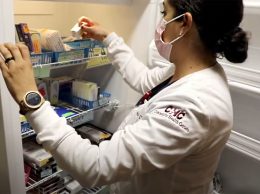Health clinics prep for influx of new patients
IN THIS ARTICLE
- Health Care & Life Science Topic
- Dana Olsen Author
By Dana Olsen Monday, July 9th, 2012
The U.S. Supreme Court’s June 28 decision to uphold President Obama’s Affordable Care Act left health care providers and consumers around the country wondering what the decision would mean for them.
Across the Tri-Counties, it’s the community clinics serving low-income families and individuals that are likely to feel the most profound effects from the health care overhaul, which requires that most American citizens obtain health insurance or pay a penalty. The law, set to go into effect in 2014 after the high court ruled 5-4 that Congress has the power to levy such a penalty tax, mandates that almost every person in the country will have insurance.
That means there will be a huge jump in the number of people seeking health care.
“We leave the politics to the politicians and we tend to see things like this through the lens of our mission. So for us, as a clinic, it means that thousands more patients will be coming our way,” Cynder Sinclair, executive director of Santa Barbara Neighborhood Clinics, told the Business Times. “On the one hand it’s great news because that’s our mission. On the other hand, we really need to gear up and expand our capacity. There are 25,000 people in the county who will become eligible for Medi-Cal who aren’t eligible now. How many of those people will be coming to our clinics?”
According to a study from the University of Wisconsin Population Health Institute, there are about 107,000 uninsured adults in Ventura County, 58,000 in Santa Barbara County and 34,000 in San Luis Obispo County. When all of those people are insured — mostly through the state’s Department of Health Care Services Medi-Cal system — it’s likely that the region’s clinics will be hit with thousands of new patients, according to health care administrators.
Congresswoman Lois Capps, a Santa Barbara Democrat, affirmed her support for the health care act in a statement on June 28. She said that in addition to starting to “fix our broken health care system,” the law will also have specific effects closer to home. “Already nearly 10,000 Central Coast young adults now have health insurance because of this law. Over 40,000 women now have access to preventive services like cancer screenings without burdensome co-pays, thousands of seniors have saved hundreds of dollars on their prescription medications and over 500 small businesses have received tax credits to make health insurance more affordable, all because of this law,” Capps said of the act, which has inspired fierce protest from some conservative members of Congress who say the individual insurance mandate oversteps the government’s power by compelling individuals to participate in the private insurance market.
Penny Borenstein, director of the San Luis Obispo Public Health Department, said there are many reasons why passage of the law is “wonderful news for public health.” It’s good news for the new recipients of health insurance and good news for clinics that provide health care to uninsured patients, she said.
“The county medical services program is just a drop in the bucket of what the uninsured people in our community need,” she said. With the affordable care act becoming a reality, the county’s clinics will be able to serve thousands more people because there will be more money going into the clinics through insurance payments.
“Community health centers live and die by insurance. They are able to take care of people without insurance only because they have enough insured people to balance their budget,” Borenstein told the Business Times. “Turning uninsured people into beneficiaries will help the clinics thrive.”
In Ventura County, an area where community clinics are already flourishing, the hope is that the act will improve the long-term health of the region’s low-income families and individuals. Robert Gonzalez, medical director of the Ventura County Health Care Agency, said that while giving people insurance may increase doctor visits in the short-term, universal coverage will eventually decrease the total number of doctor visits in the county.
Ventura County is one of 10 counties that receives funding from a four-year-old state program called Access, Coverage, Enrollment (ACE) that provides health insurance to low-income people. Thanks to that program, the region has already upped its access to primary care. “With the support of the county board of supervisors and county executive officer Michael Powers, our system of Ventura County Medical Center-affiliated clinics and Clinicas del Camino Real have worked hard in the past two years to ramp up capacity to accommodate additional patients,” Gonzalez said. “When our patients started to enroll in the ACE program, we found a lot of pent-up need. When patients got coverage, they came in and we saw a bump in care. We were able to implement preventative medical services and manage chronic diseases … in the long-run, that will decrease the dollars spent on medical care.”
Santa Barbara Neighborhood Clinics is starting to do what clinics in Ventura County have already done. To prepare for the affordable care act’s implementation, clinic hours will be extended starting this month. The nonprofit organization plans to grow its capacity by 30 percent to 50 percent between 2014 and 2017, Sinclair said, which may mean opening a brand-new clinic in Goleta in addition to its Isla Vista and downtown locations.
Right now, statistics show that almost 30,000 people living between Goleta and Carpinteria don’t receive any health care at all because they can’t pay for it. Even though community clinics provide care to people who cannot pay, Sinclair said many people don’t seek free health care because they don’t want to take advantage of handouts. The universal insurance mandate “means that a lot more people are going to be taken care of,” she said.
“There’s a lot going on with the act, but really, upholding the law was a vote of confidence,” Sinclair said. “It acknowledged the work we do and the importance of providing health care for our fellow humans.”
Related Articles
 Friday, September 16th, 2022
Friday, September 16th, 2022











